Analyzing Physical Activity for Prevention of Heart Related Conditions
VerifiedAdded on 2023/05/29
|6
|1568
|443
Essay
AI Summary
This essay examines the effectiveness of physical activity in preventing and improving heart-related conditions, particularly in the context of increasing heart diseases in North America. It highlights the role of physical activity in controlling elevated cholesterol levels, managing weight, and reducing the risk factors associated with heart disorders such as high blood pressure, diabetes, and obesity. The essay emphasizes that incorporating regular exercise, even moderate activity for 30 minutes daily, can significantly lower the risk of heart attacks, improve blood cholesterol levels, and alleviate stress and depression. Furthermore, it discusses how physical activity strengthens muscles, enhances the immune system, and promotes overall well-being, making it a crucial component in maintaining cardiovascular health and preventing long-term health issues associated with heart disease. The essay concludes that consistent physical activity is essential for individuals, especially those at risk of or already suffering from heart conditions, to improve their health status and overall quality of life. Desklib provides access to similar solved assignments and study resources.

Physical Activity and Health Promotion
Paraphrase This Document
Need a fresh take? Get an instant paraphrase of this document with our AI Paraphraser
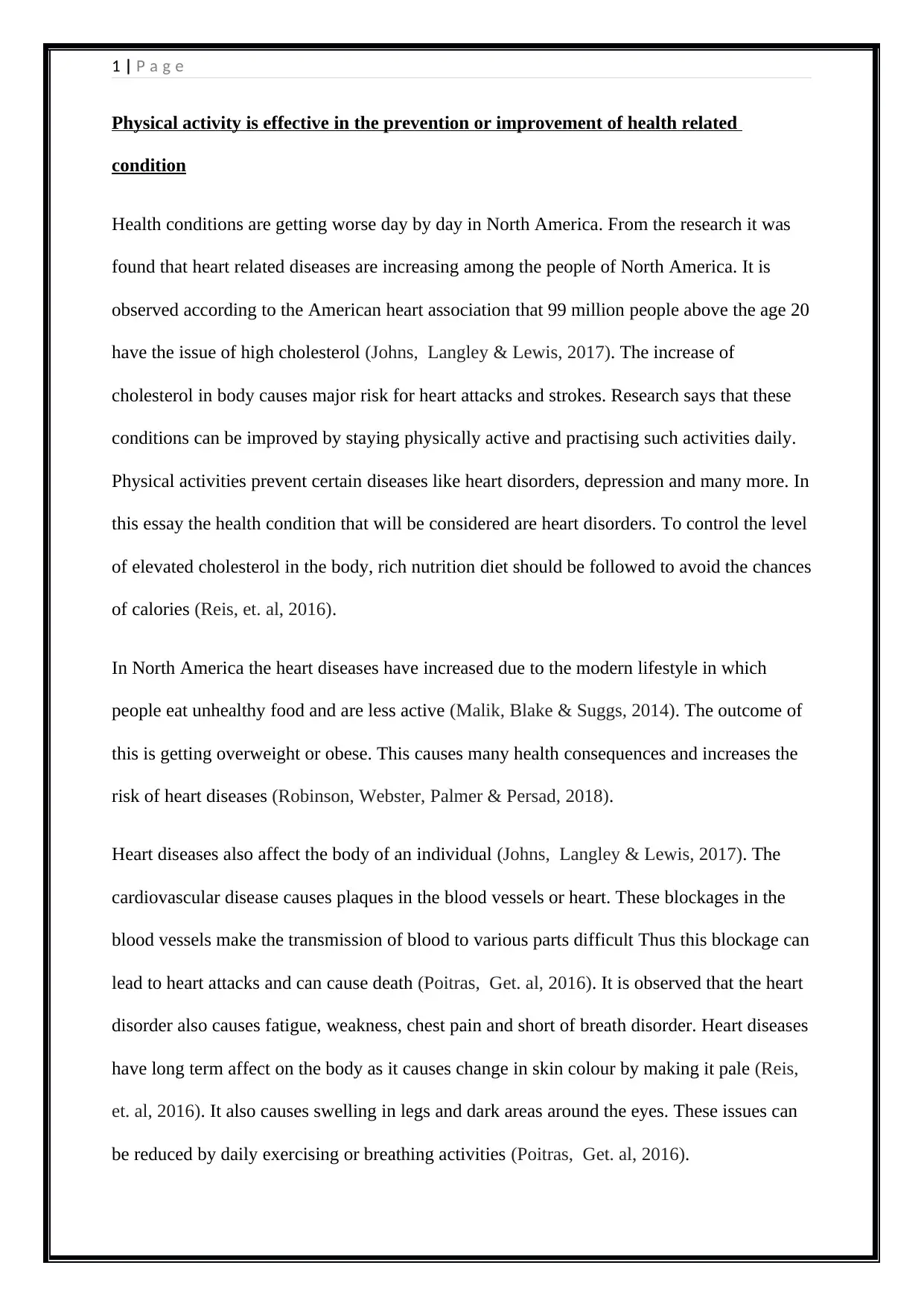
1 | P a g e
Physical activity is effective in the prevention or improvement of health related
condition
Health conditions are getting worse day by day in North America. From the research it was
found that heart related diseases are increasing among the people of North America. It is
observed according to the American heart association that 99 million people above the age 20
have the issue of high cholesterol (Johns, Langley & Lewis, 2017). The increase of
cholesterol in body causes major risk for heart attacks and strokes. Research says that these
conditions can be improved by staying physically active and practising such activities daily.
Physical activities prevent certain diseases like heart disorders, depression and many more. In
this essay the health condition that will be considered are heart disorders. To control the level
of elevated cholesterol in the body, rich nutrition diet should be followed to avoid the chances
of calories (Reis, et. al, 2016).
In North America the heart diseases have increased due to the modern lifestyle in which
people eat unhealthy food and are less active (Malik, Blake & Suggs, 2014). The outcome of
this is getting overweight or obese. This causes many health consequences and increases the
risk of heart diseases (Robinson, Webster, Palmer & Persad, 2018).
Heart diseases also affect the body of an individual (Johns, Langley & Lewis, 2017). The
cardiovascular disease causes plaques in the blood vessels or heart. These blockages in the
blood vessels make the transmission of blood to various parts difficult Thus this blockage can
lead to heart attacks and can cause death (Poitras, Get. al, 2016). It is observed that the heart
disorder also causes fatigue, weakness, chest pain and short of breath disorder. Heart diseases
have long term affect on the body as it causes change in skin colour by making it pale (Reis,
et. al, 2016). It also causes swelling in legs and dark areas around the eyes. These issues can
be reduced by daily exercising or breathing activities (Poitras, Get. al, 2016).
Physical activity is effective in the prevention or improvement of health related
condition
Health conditions are getting worse day by day in North America. From the research it was
found that heart related diseases are increasing among the people of North America. It is
observed according to the American heart association that 99 million people above the age 20
have the issue of high cholesterol (Johns, Langley & Lewis, 2017). The increase of
cholesterol in body causes major risk for heart attacks and strokes. Research says that these
conditions can be improved by staying physically active and practising such activities daily.
Physical activities prevent certain diseases like heart disorders, depression and many more. In
this essay the health condition that will be considered are heart disorders. To control the level
of elevated cholesterol in the body, rich nutrition diet should be followed to avoid the chances
of calories (Reis, et. al, 2016).
In North America the heart diseases have increased due to the modern lifestyle in which
people eat unhealthy food and are less active (Malik, Blake & Suggs, 2014). The outcome of
this is getting overweight or obese. This causes many health consequences and increases the
risk of heart diseases (Robinson, Webster, Palmer & Persad, 2018).
Heart diseases also affect the body of an individual (Johns, Langley & Lewis, 2017). The
cardiovascular disease causes plaques in the blood vessels or heart. These blockages in the
blood vessels make the transmission of blood to various parts difficult Thus this blockage can
lead to heart attacks and can cause death (Poitras, Get. al, 2016). It is observed that the heart
disorder also causes fatigue, weakness, chest pain and short of breath disorder. Heart diseases
have long term affect on the body as it causes change in skin colour by making it pale (Reis,
et. al, 2016). It also causes swelling in legs and dark areas around the eyes. These issues can
be reduced by daily exercising or breathing activities (Poitras, Get. al, 2016).
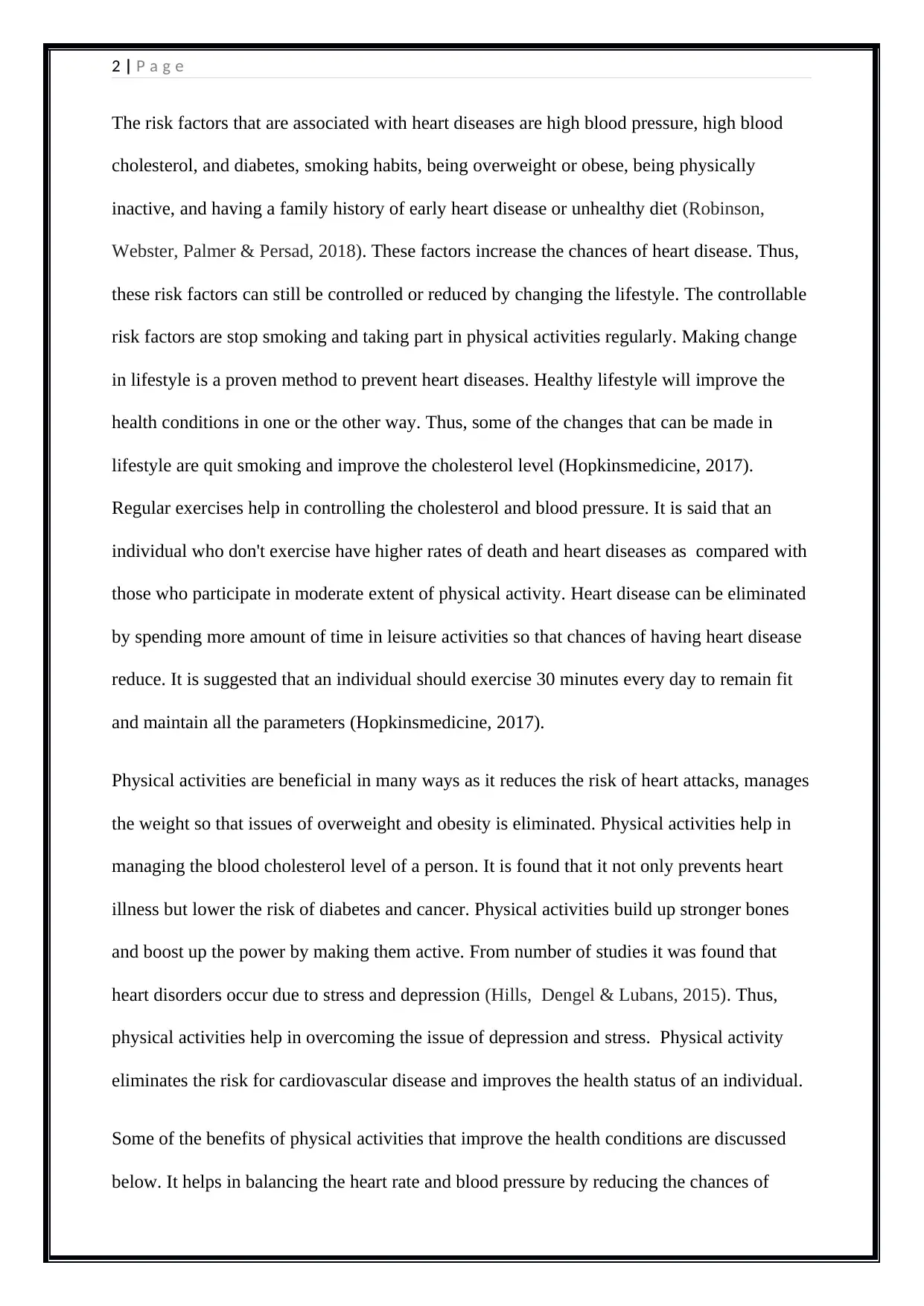
2 | P a g e
The risk factors that are associated with heart diseases are high blood pressure, high blood
cholesterol, and diabetes, smoking habits, being overweight or obese, being physically
inactive, and having a family history of early heart disease or unhealthy diet (Robinson,
Webster, Palmer & Persad, 2018). These factors increase the chances of heart disease. Thus,
these risk factors can still be controlled or reduced by changing the lifestyle. The controllable
risk factors are stop smoking and taking part in physical activities regularly. Making change
in lifestyle is a proven method to prevent heart diseases. Healthy lifestyle will improve the
health conditions in one or the other way. Thus, some of the changes that can be made in
lifestyle are quit smoking and improve the cholesterol level (Hopkinsmedicine, 2017).
Regular exercises help in controlling the cholesterol and blood pressure. It is said that an
individual who don't exercise have higher rates of death and heart diseases as compared with
those who participate in moderate extent of physical activity. Heart disease can be eliminated
by spending more amount of time in leisure activities so that chances of having heart disease
reduce. It is suggested that an individual should exercise 30 minutes every day to remain fit
and maintain all the parameters (Hopkinsmedicine, 2017).
Physical activities are beneficial in many ways as it reduces the risk of heart attacks, manages
the weight so that issues of overweight and obesity is eliminated. Physical activities help in
managing the blood cholesterol level of a person. It is found that it not only prevents heart
illness but lower the risk of diabetes and cancer. Physical activities build up stronger bones
and boost up the power by making them active. From number of studies it was found that
heart disorders occur due to stress and depression (Hills, Dengel & Lubans, 2015). Thus,
physical activities help in overcoming the issue of depression and stress. Physical activity
eliminates the risk for cardiovascular disease and improves the health status of an individual.
Some of the benefits of physical activities that improve the health conditions are discussed
below. It helps in balancing the heart rate and blood pressure by reducing the chances of
The risk factors that are associated with heart diseases are high blood pressure, high blood
cholesterol, and diabetes, smoking habits, being overweight or obese, being physically
inactive, and having a family history of early heart disease or unhealthy diet (Robinson,
Webster, Palmer & Persad, 2018). These factors increase the chances of heart disease. Thus,
these risk factors can still be controlled or reduced by changing the lifestyle. The controllable
risk factors are stop smoking and taking part in physical activities regularly. Making change
in lifestyle is a proven method to prevent heart diseases. Healthy lifestyle will improve the
health conditions in one or the other way. Thus, some of the changes that can be made in
lifestyle are quit smoking and improve the cholesterol level (Hopkinsmedicine, 2017).
Regular exercises help in controlling the cholesterol and blood pressure. It is said that an
individual who don't exercise have higher rates of death and heart diseases as compared with
those who participate in moderate extent of physical activity. Heart disease can be eliminated
by spending more amount of time in leisure activities so that chances of having heart disease
reduce. It is suggested that an individual should exercise 30 minutes every day to remain fit
and maintain all the parameters (Hopkinsmedicine, 2017).
Physical activities are beneficial in many ways as it reduces the risk of heart attacks, manages
the weight so that issues of overweight and obesity is eliminated. Physical activities help in
managing the blood cholesterol level of a person. It is found that it not only prevents heart
illness but lower the risk of diabetes and cancer. Physical activities build up stronger bones
and boost up the power by making them active. From number of studies it was found that
heart disorders occur due to stress and depression (Hills, Dengel & Lubans, 2015). Thus,
physical activities help in overcoming the issue of depression and stress. Physical activity
eliminates the risk for cardiovascular disease and improves the health status of an individual.
Some of the benefits of physical activities that improve the health conditions are discussed
below. It helps in balancing the heart rate and blood pressure by reducing the chances of
⊘ This is a preview!⊘
Do you want full access?
Subscribe today to unlock all pages.

Trusted by 1+ million students worldwide
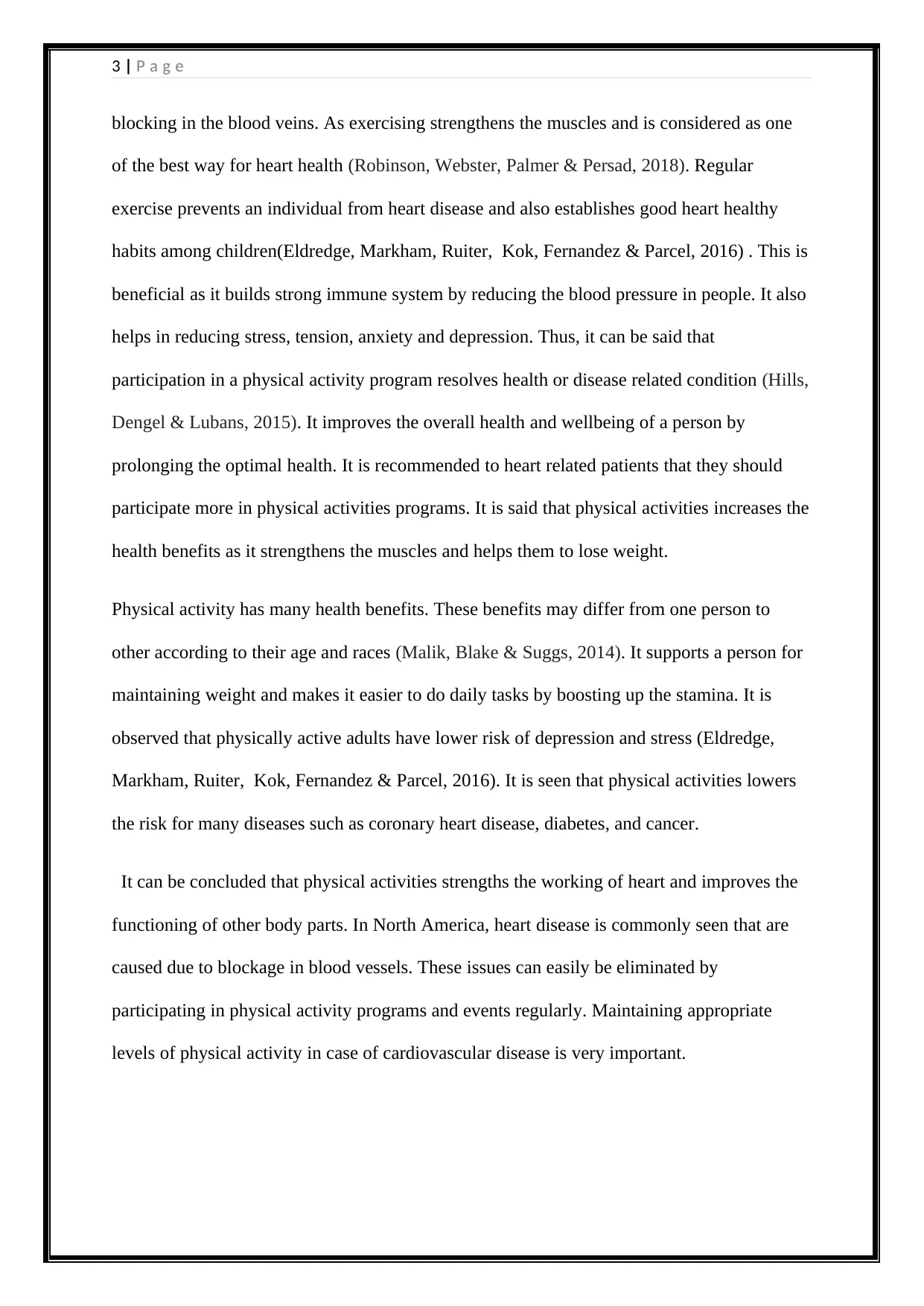
3 | P a g e
blocking in the blood veins. As exercising strengthens the muscles and is considered as one
of the best way for heart health (Robinson, Webster, Palmer & Persad, 2018). Regular
exercise prevents an individual from heart disease and also establishes good heart healthy
habits among children(Eldredge, Markham, Ruiter, Kok, Fernandez & Parcel, 2016) . This is
beneficial as it builds strong immune system by reducing the blood pressure in people. It also
helps in reducing stress, tension, anxiety and depression. Thus, it can be said that
participation in a physical activity program resolves health or disease related condition (Hills,
Dengel & Lubans, 2015). It improves the overall health and wellbeing of a person by
prolonging the optimal health. It is recommended to heart related patients that they should
participate more in physical activities programs. It is said that physical activities increases the
health benefits as it strengthens the muscles and helps them to lose weight.
Physical activity has many health benefits. These benefits may differ from one person to
other according to their age and races (Malik, Blake & Suggs, 2014). It supports a person for
maintaining weight and makes it easier to do daily tasks by boosting up the stamina. It is
observed that physically active adults have lower risk of depression and stress (Eldredge,
Markham, Ruiter, Kok, Fernandez & Parcel, 2016). It is seen that physical activities lowers
the risk for many diseases such as coronary heart disease, diabetes, and cancer.
It can be concluded that physical activities strengths the working of heart and improves the
functioning of other body parts. In North America, heart disease is commonly seen that are
caused due to blockage in blood vessels. These issues can easily be eliminated by
participating in physical activity programs and events regularly. Maintaining appropriate
levels of physical activity in case of cardiovascular disease is very important.
blocking in the blood veins. As exercising strengthens the muscles and is considered as one
of the best way for heart health (Robinson, Webster, Palmer & Persad, 2018). Regular
exercise prevents an individual from heart disease and also establishes good heart healthy
habits among children(Eldredge, Markham, Ruiter, Kok, Fernandez & Parcel, 2016) . This is
beneficial as it builds strong immune system by reducing the blood pressure in people. It also
helps in reducing stress, tension, anxiety and depression. Thus, it can be said that
participation in a physical activity program resolves health or disease related condition (Hills,
Dengel & Lubans, 2015). It improves the overall health and wellbeing of a person by
prolonging the optimal health. It is recommended to heart related patients that they should
participate more in physical activities programs. It is said that physical activities increases the
health benefits as it strengthens the muscles and helps them to lose weight.
Physical activity has many health benefits. These benefits may differ from one person to
other according to their age and races (Malik, Blake & Suggs, 2014). It supports a person for
maintaining weight and makes it easier to do daily tasks by boosting up the stamina. It is
observed that physically active adults have lower risk of depression and stress (Eldredge,
Markham, Ruiter, Kok, Fernandez & Parcel, 2016). It is seen that physical activities lowers
the risk for many diseases such as coronary heart disease, diabetes, and cancer.
It can be concluded that physical activities strengths the working of heart and improves the
functioning of other body parts. In North America, heart disease is commonly seen that are
caused due to blockage in blood vessels. These issues can easily be eliminated by
participating in physical activity programs and events regularly. Maintaining appropriate
levels of physical activity in case of cardiovascular disease is very important.
Paraphrase This Document
Need a fresh take? Get an instant paraphrase of this document with our AI Paraphraser
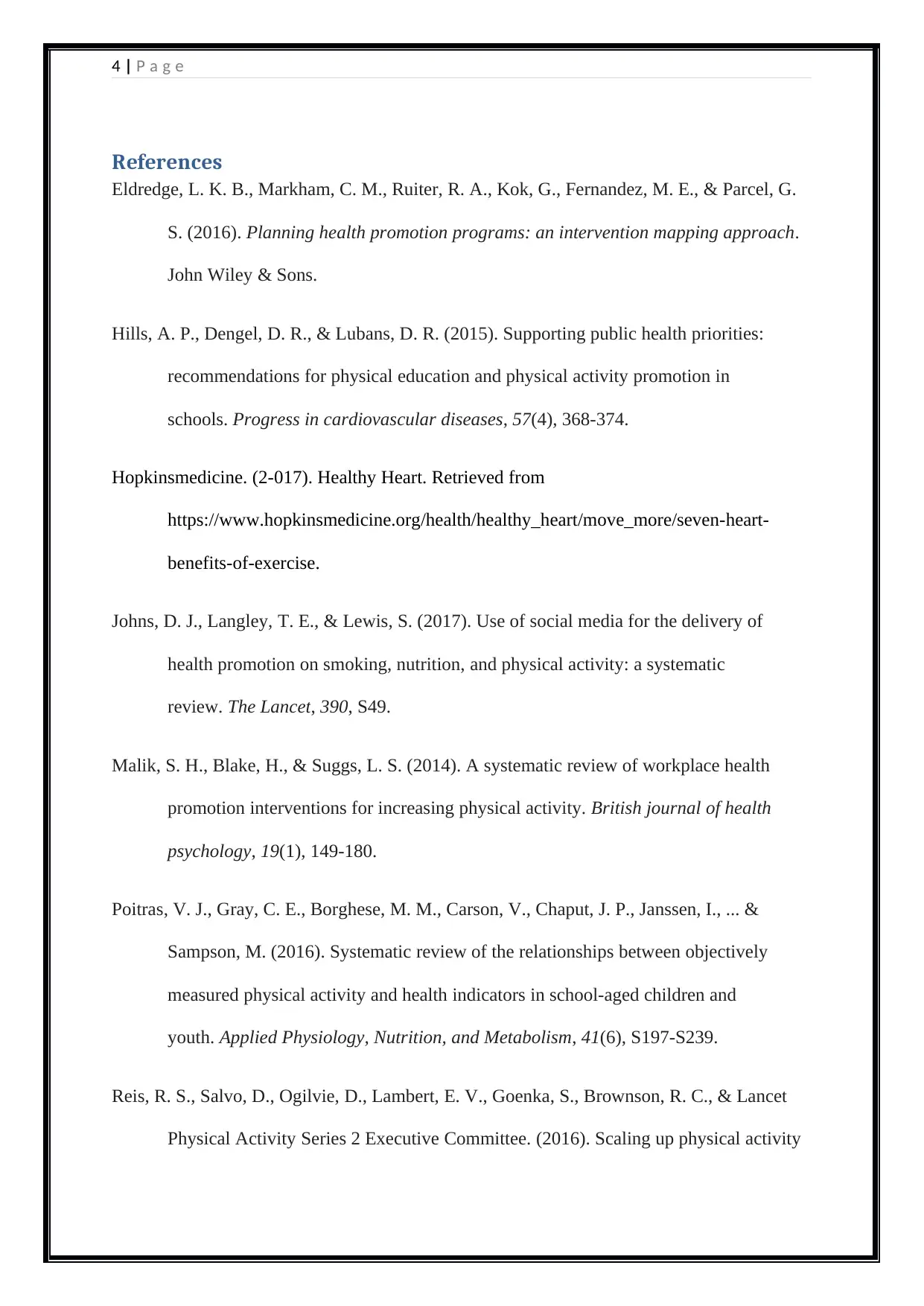
4 | P a g e
References
Eldredge, L. K. B., Markham, C. M., Ruiter, R. A., Kok, G., Fernandez, M. E., & Parcel, G.
S. (2016). Planning health promotion programs: an intervention mapping approach.
John Wiley & Sons.
Hills, A. P., Dengel, D. R., & Lubans, D. R. (2015). Supporting public health priorities:
recommendations for physical education and physical activity promotion in
schools. Progress in cardiovascular diseases, 57(4), 368-374.
Hopkinsmedicine. (2-017). Healthy Heart. Retrieved from
https://www.hopkinsmedicine.org/health/healthy_heart/move_more/seven-heart-
benefits-of-exercise.
Johns, D. J., Langley, T. E., & Lewis, S. (2017). Use of social media for the delivery of
health promotion on smoking, nutrition, and physical activity: a systematic
review. The Lancet, 390, S49.
Malik, S. H., Blake, H., & Suggs, L. S. (2014). A systematic review of workplace health
promotion interventions for increasing physical activity. British journal of health
psychology, 19(1), 149-180.
Poitras, V. J., Gray, C. E., Borghese, M. M., Carson, V., Chaput, J. P., Janssen, I., ... &
Sampson, M. (2016). Systematic review of the relationships between objectively
measured physical activity and health indicators in school-aged children and
youth. Applied Physiology, Nutrition, and Metabolism, 41(6), S197-S239.
Reis, R. S., Salvo, D., Ogilvie, D., Lambert, E. V., Goenka, S., Brownson, R. C., & Lancet
Physical Activity Series 2 Executive Committee. (2016). Scaling up physical activity
References
Eldredge, L. K. B., Markham, C. M., Ruiter, R. A., Kok, G., Fernandez, M. E., & Parcel, G.
S. (2016). Planning health promotion programs: an intervention mapping approach.
John Wiley & Sons.
Hills, A. P., Dengel, D. R., & Lubans, D. R. (2015). Supporting public health priorities:
recommendations for physical education and physical activity promotion in
schools. Progress in cardiovascular diseases, 57(4), 368-374.
Hopkinsmedicine. (2-017). Healthy Heart. Retrieved from
https://www.hopkinsmedicine.org/health/healthy_heart/move_more/seven-heart-
benefits-of-exercise.
Johns, D. J., Langley, T. E., & Lewis, S. (2017). Use of social media for the delivery of
health promotion on smoking, nutrition, and physical activity: a systematic
review. The Lancet, 390, S49.
Malik, S. H., Blake, H., & Suggs, L. S. (2014). A systematic review of workplace health
promotion interventions for increasing physical activity. British journal of health
psychology, 19(1), 149-180.
Poitras, V. J., Gray, C. E., Borghese, M. M., Carson, V., Chaput, J. P., Janssen, I., ... &
Sampson, M. (2016). Systematic review of the relationships between objectively
measured physical activity and health indicators in school-aged children and
youth. Applied Physiology, Nutrition, and Metabolism, 41(6), S197-S239.
Reis, R. S., Salvo, D., Ogilvie, D., Lambert, E. V., Goenka, S., Brownson, R. C., & Lancet
Physical Activity Series 2 Executive Committee. (2016). Scaling up physical activity
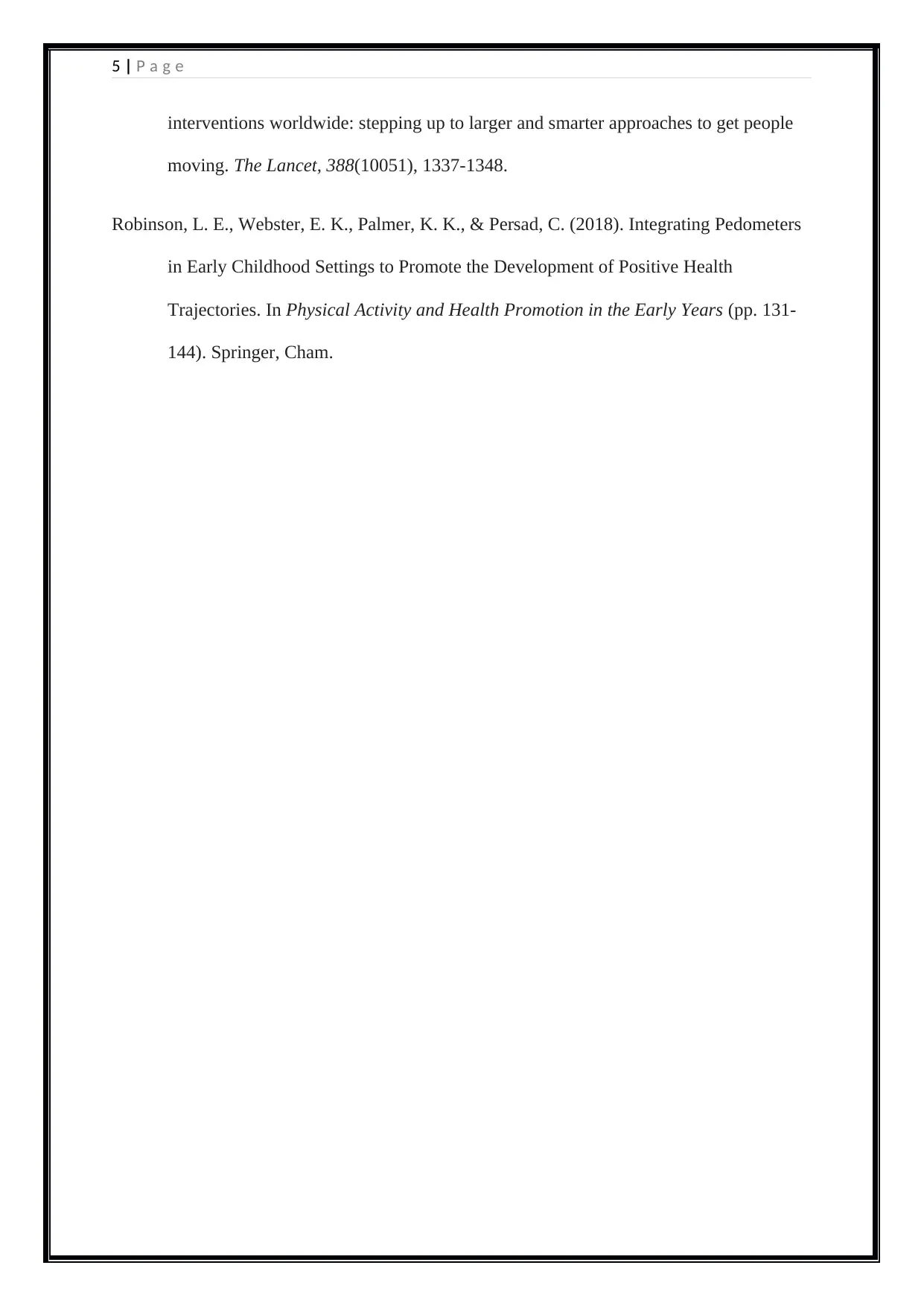
5 | P a g e
interventions worldwide: stepping up to larger and smarter approaches to get people
moving. The Lancet, 388(10051), 1337-1348.
Robinson, L. E., Webster, E. K., Palmer, K. K., & Persad, C. (2018). Integrating Pedometers
in Early Childhood Settings to Promote the Development of Positive Health
Trajectories. In Physical Activity and Health Promotion in the Early Years (pp. 131-
144). Springer, Cham.
interventions worldwide: stepping up to larger and smarter approaches to get people
moving. The Lancet, 388(10051), 1337-1348.
Robinson, L. E., Webster, E. K., Palmer, K. K., & Persad, C. (2018). Integrating Pedometers
in Early Childhood Settings to Promote the Development of Positive Health
Trajectories. In Physical Activity and Health Promotion in the Early Years (pp. 131-
144). Springer, Cham.
⊘ This is a preview!⊘
Do you want full access?
Subscribe today to unlock all pages.

Trusted by 1+ million students worldwide
1 out of 6
Related Documents
Your All-in-One AI-Powered Toolkit for Academic Success.
+13062052269
info@desklib.com
Available 24*7 on WhatsApp / Email
![[object Object]](/_next/static/media/star-bottom.7253800d.svg)
Unlock your academic potential
Copyright © 2020–2025 A2Z Services. All Rights Reserved. Developed and managed by ZUCOL.





